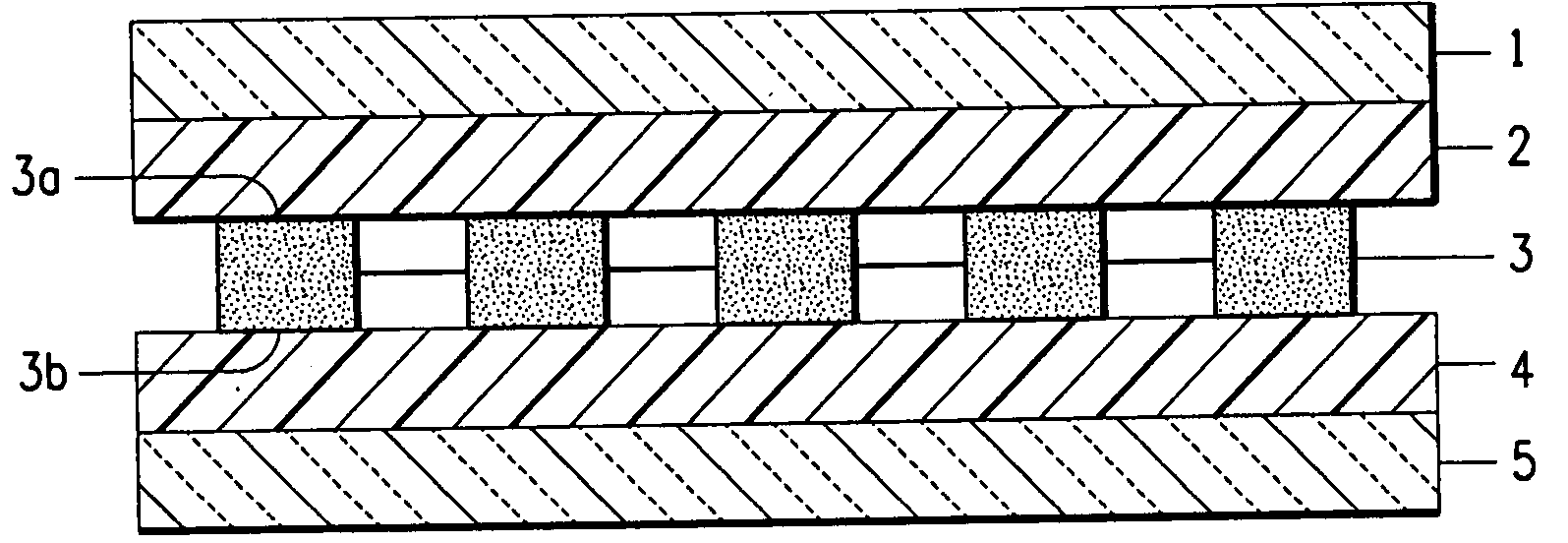Solar cells encapsulated with poly(vinyl butyral)
a technology of poly(vinyl butyral) and solar cells, applied in the field of solar cell modules, can solve the problems of complex process to produce such solar cell laminates for commercial use, affect the efficiency of light transmission, and complex use of pre-formed highly plasticized poly(vinyl butyral) sheets as solar cell encapsulant layers
- Summary
- Abstract
- Description
- Claims
- Application Information
AI Technical Summary
Benefits of technology
Problems solved by technology
Method used
Image
Examples
examples
[0113]The following Examples are intended to be illustrative of the present invention, and are not intended in any way to limit the scope of the present invention. The solar cell interconnections are omitted from the examples below to clarify the structures, but any common art solar cell interconnections may be utilized within the present invention.
Methods
[0114]The following methods are used in the Examples presented hereafter.
I. Lamination Process 1:
[0115]The laminate layers described below are stacked (laid up) to form the pre-laminate assembly described within the examples. For the assembly containing a film layer as the incident or back-sheet layer, a cover glass sheet is placed over the film layer. The pre-laminate assembly is then placed within a vacuum bag, the vacuum bag is sealed and a vacuum is applied to remove the air from the vacuum bag. The bag is placed into an oven and while maintaining the application of the vacuum to the vacuum bag, the vacuum bag is heated at 135°...
examples 1-14
[0117]The 12-inch by 12-inch solar cell pre-laminate assemblies described below in Table 1 are assembled and laminated by Lamination Process 1. In each assembly, the layers are described in the order of from top (i.e., the incident layer) to bottom (i.e., the back-sheet).
TABLE 1Solar Cell Laminate StructuresExampleLayer 1Layer 2Layer 3Layer 4Layer 51, 15Glass 1PVB S1Solar Cell 1PVB S1Glass 12, 16Glass 2PVB S2Solar Cell 2PVB S2Glass 23, 17Glass 1PVB S3Solar Cell 3PVB S3Glass 24, 18Glass 1PVB S1Solar Cell 4PVB S1Glass 25, 19FPFPVB S3Solar Cell 1PVB S3FPF6, 20Glass 1PVB S2Solar Cell 1Ionomer 1Glass 37, 21FPFPVB S1Solar Cell 4EBAAL8, 22Glass 1PVB S3Solar Cell 1ACRAL9, 23Glass 2Ionomer 2Solar Cell 4PVB S1AL10, 24FPFPVB S2Solar Cell 1PVB AGlass 211, 25FPFPVB S3Solar Cell 4EMAFPF12, 26Glass 1PVB S1Solar Cell 1PVB S1AL13, 27Glass 1PVB S3Solar Cell 2EVAGlass 114, 28Glass 2PVB S1Solar Cell 1PVBGlass[0118]ACR is a 20 mil (0.51 mm) thick embossed sheet of a poly(ethylene-co-methacrylic acid) co...
examples 15-28
[0138]The 12-inch by 12-inch solar cell pre-laminate assemblies described above in Table 1 are assembled and laminated by Lamination Process 2. In each assembly, the layers are described in the order of from top (i.e., the incident layer) to bottom (i.e., the back-sheet).
PUM
| Property | Measurement | Unit |
|---|---|---|
| Temperature | aaaaa | aaaaa |
| Temperature | aaaaa | aaaaa |
| Length | aaaaa | aaaaa |
Abstract
Description
Claims
Application Information
 Login to View More
Login to View More - R&D
- Intellectual Property
- Life Sciences
- Materials
- Tech Scout
- Unparalleled Data Quality
- Higher Quality Content
- 60% Fewer Hallucinations
Browse by: Latest US Patents, China's latest patents, Technical Efficacy Thesaurus, Application Domain, Technology Topic, Popular Technical Reports.
© 2025 PatSnap. All rights reserved.Legal|Privacy policy|Modern Slavery Act Transparency Statement|Sitemap|About US| Contact US: help@patsnap.com


